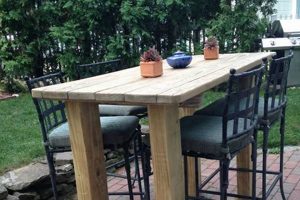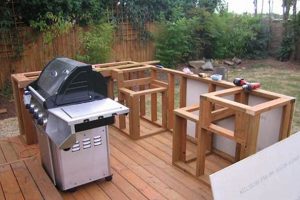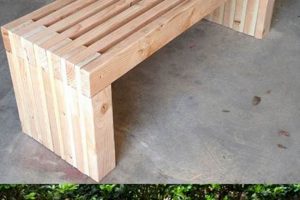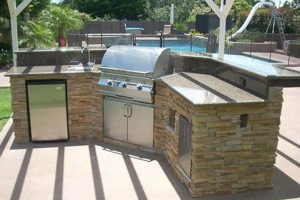Constructions designed to obscure views and enhance seclusion in exterior environments, frequently assembled from readily available materials by individuals, are a common feature in residential landscaping. These structures serve as visual barriers, increasing the sense of personal space and minimizing disturbances from neighbors or public thoroughfares. Examples include wooden panels, strategically placed vegetation, or repurposed materials fashioned into an aesthetic and functional partition.
The implementation of these outdoor screening solutions provides numerous advantages. Beyond the obvious enhancement of privacy, these barriers can also offer protection from wind and sun, thereby creating more comfortable and usable outdoor living spaces. Historically, such screens have been employed to define property lines, create sheltered gardens, and establish secluded areas for relaxation or recreation. Their prevalence underscores a consistent human desire to control the visual environment and cultivate a sense of personal sanctuary.
The following sections will detail the various construction methods, material options, and design considerations involved in creating personalized outdoor barriers. This exploration will cover aspects from selecting appropriate materials and planning the structure to implementing effective design elements that complement the surrounding environment and achieve the desired level of screening and aesthetic appeal.
Construction and Placement Considerations
The following guidelines are designed to assist in the creation of effective and durable outdoor privacy screens. Careful planning and execution are essential to achieving the desired level of seclusion and aesthetic integration.
Tip 1: Material Selection is Critical: Choose materials that are weather-resistant and appropriate for the local climate. Untreated wood, for example, may require regular maintenance or a protective sealant to prevent rot and decay. Durable options include cedar, redwood, composite lumber, or metal.
Tip 2: Consider Local Regulations: Prior to commencement of construction, verify any applicable local ordinances, building codes, or homeowners’ association guidelines regarding fence heights, setback requirements, and permissible materials. Non-compliance can result in costly modifications or removal.
Tip 3: Structural Integrity is Paramount: Ensure the screen is structurally sound and capable of withstanding wind loads. Proper anchoring and support are essential, particularly for taller screens. Consider using concrete footings for posts and employing adequate bracing.
Tip 4: Account for Sunlight and Drainage: Design the screen to allow for adequate sunlight penetration and drainage. Solid screens can cast significant shadows and impede airflow. Integrate gaps or permeable elements to mitigate these effects and prevent water accumulation.
Tip 5: Prioritize Integration with Existing Landscape: Aim to integrate the screen seamlessly with the surrounding landscape. Consider the existing vegetation, architectural style of the property, and overall aesthetic. The screen should complement, not detract from, the existing environment.
Tip 6: Consider Adjustable Options: Fixed screens provide constant privacy, but adjustable or moveable screens offer flexibility. Consider screens that can be opened or closed, or panels on wheels that can be moved to different locations as needed.
Tip 7: Anticipate Maintenance Requirements: Factor in the long-term maintenance requirements of the selected materials and design. Regular cleaning, painting, or sealing may be necessary to maintain the screen’s appearance and structural integrity.
Adherence to these recommendations will contribute to the successful construction of a functional and aesthetically pleasing structure, effectively enhancing outdoor privacy and comfort.
The concluding section will provide insights into ongoing maintenance and potential enhancements that can further extend the lifespan and utility of the privacy screen.
1. Material Weather Resistance
The successful implementation of independently constructed outdoor privacy solutions hinges significantly on the selection of materials exhibiting robust weather resistance. Material degradation due to exposure to environmental elements directly undermines the structural integrity and aesthetic appeal of such screens. Cause-and-effect relationships are readily apparent; prolonged exposure to moisture leads to wood rot and decay, while ultraviolet radiation causes fading and embrittlement in many plastics and fabrics. Without appropriate material selection, the initial investment in labor and resources can be quickly negated by premature failure. For example, using untreated pine in a high-humidity environment invariably results in a significantly shorter lifespan compared to utilizing naturally weather-resistant materials like cedar or redwood, or employing treated lumber designed to withstand such conditions. The practical significance of understanding weather resistance is therefore paramount in ensuring the longevity and sustained effectiveness of the privacy screen.
Further, consider the practical applications of specific weather-resistant materials. Pressure-treated lumber offers protection against fungal decay and insect infestation, extending the usable life of wooden structures. Composite lumber, manufactured from recycled plastic and wood fibers, provides resistance to moisture, insects, and fading, requiring minimal maintenance. Metal options, such as powder-coated aluminum or galvanized steel, offer excellent durability and corrosion resistance, particularly in coastal environments. In each instance, the informed selection of materials based on environmental factors and anticipated exposure translates directly into reduced maintenance, prolonged structural integrity, and sustained aesthetic quality.
In summary, the intrinsic connection between material weather resistance and the efficacy of self-assembled outdoor privacy structures cannot be overstated. Ignoring this critical factor introduces the significant challenge of premature failure and increased maintenance burdens. By prioritizing materials designed to withstand the specific environmental conditions of the installation site, individuals can ensure a long-lasting, functional, and visually appealing privacy solution, thereby maximizing the value of their efforts and resources. The choice of material is a cornerstone to the broader objective.
2. Structural Stability
The integrity of self-assembled outdoor privacy screens is intrinsically linked to their structural stability. A lack of sufficient structural integrity directly compromises the screen’s functionality, longevity, and safety. External forces, such as wind, snow, and even leaning, can exert significant pressure on the screen, leading to instability, deformation, or even collapse. The result is not only a failure to provide the intended privacy but also potential property damage or, in severe cases, personal injury. A poorly constructed screen, for instance, using inadequate post anchoring or insufficient bracing, may succumb to strong winds, requiring costly repairs or complete replacement. Therefore, structural stability is not merely a desirable attribute but a fundamental necessity for any independently built privacy screen.
Practical application of structural principles involves several key considerations. The depth and diameter of post footings must be appropriate for the height and weight of the screen, as well as the prevailing soil conditions. The spacing between posts should be determined by the load-bearing capacity of the chosen materials and the expected wind exposure. Proper joinery techniques, such as using screws or bolts rather than nails, enhance the strength and rigidity of the structure. Furthermore, incorporating bracing elements, like diagonal supports, significantly increases resistance to lateral forces. Consider a tall screen constructed in a windy area; without adequate bracing, it acts as a sail, amplifying the force exerted on the posts and increasing the risk of failure. Adhering to established engineering principles ensures the screen remains stable and functional under a variety of environmental conditions.
In conclusion, the connection between structural stability and the successful implementation of outdoor privacy screens is undeniable. Addressing structural concerns from the outset is crucial for long-term performance and safety. Neglecting these principles results in a compromised screen prone to failure and potentially hazardous conditions. By prioritizing sound construction techniques and utilizing appropriate materials, individuals can create screens that not only provide privacy but also withstand the rigors of outdoor exposure, ensuring lasting value and peace of mind. The initial investment in robust construction is a worthwhile endeavor.
3. Privacy Level Achieved
The degree of seclusion attained by a self-constructed outdoor screening structure represents a primary determinant of its overall effectiveness and value. The correlation between design choices, material selection, and construction techniques directly dictates the level of visual and auditory isolation achieved, thereby fulfilling the core objective of creating a more private and comfortable outdoor environment. The success of the project hinges upon a clear understanding of these relationships.
- Material Density and Opacity
The intrinsic properties of the chosen materials significantly impact the level of privacy. Opaque materials such as solid wood panels or tightly woven fabrics offer maximum visual obstruction, while more translucent materials such as latticework or open weave screens provide partial screening. The selection should align with the desired degree of seclusion. For instance, a dense wooden fence effectively blocks views from adjacent properties, whereas a screen with strategically placed gaps allows for airflow and filtered sunlight while still providing a degree of visual separation. The implication is that careful material selection is paramount in achieving the intended privacy level.
- Height and Placement of the Structure
The dimensions and location of the screen play a crucial role in defining the private area. A taller screen provides greater vertical coverage, effectively blocking views from elevated vantage points. The proximity of the screen to the area requiring privacy, such as a patio or deck, also influences its effectiveness. A screen positioned too far from the intended space offers limited seclusion. Real-world examples include positioning a screen strategically to block views from a second-story window or extending a screen along a property line to minimize visibility from neighboring properties. Optimal height and placement are critical for maximizing privacy.
- Screen Design and Configuration
The specific design and arrangement of the screening elements significantly influence the level of privacy. Solid panels provide maximum obstruction, while spaced slats or interwoven patterns allow for partial visibility and airflow. The angle and orientation of the screening elements can also be manipulated to direct views and enhance privacy. Examples include angled slats that block direct line-of-sight while allowing indirect light to pass through, or staggered panels that create a sense of depth and visual separation. Thoughtful design choices contribute significantly to the overall privacy achieved.
- Integration with Existing Landscape
The incorporation of existing or newly planted vegetation can augment the privacy provided by the constructed screen. Strategic placement of trees, shrubs, or climbing plants can create a natural barrier that further obscures views and enhances the sense of seclusion. For example, planting a row of evergreen trees behind a screen provides a year-round privacy solution, while climbing vines trained on the screen itself create a living wall that enhances both privacy and aesthetic appeal. Effective landscape integration amplifies the privacy provided by the structure.
In summation, achieving the desired level of seclusion through independently constructed outdoor screens requires a holistic approach encompassing thoughtful material selection, strategic placement, deliberate design choices, and harmonious landscape integration. The convergence of these factors determines the ultimate efficacy of the screen in fulfilling its primary purpose: to create a private and comfortable outdoor environment. The projects success hinges on these interrelated design elements.
4. Aesthetic Integration
The successful incorporation of independently constructed outdoor privacy screens necessitates a comprehensive understanding of aesthetic integration. The screen should not only provide privacy but also seamlessly blend with the surrounding environment, enhancing the overall visual appeal of the property. Achieving this balance requires careful consideration of various design elements and their interrelation.
- Architectural Harmony
The design of the screen should complement the architectural style of the house and other existing structures. Materials, colors, and patterns should be chosen to create a cohesive look. For instance, a modern home with clean lines might benefit from a screen constructed from sleek metal or minimalist wood panels, while a more traditional home could be enhanced by a screen made of natural wood with intricate detailing. Disparate styles create visual discord and detract from the property’s overall aesthetic.
- Landscape Compatibility
The screen should integrate harmoniously with the existing landscape. Consider the colors, textures, and forms of the surrounding vegetation and incorporate elements that echo these features. A screen constructed from natural materials, such as wood or bamboo, can blend seamlessly with a garden setting, while a screen incorporating climbing plants can create a living wall that enhances both privacy and visual appeal. The goal is to create a sense of continuity and flow between the screen and its natural surroundings.
- Color Palette and Material Texture
The color palette and material texture of the screen should be carefully selected to complement the overall design scheme. Neutral colors, such as grays, browns, and greens, tend to blend well with most environments, while bolder colors can be used to create a focal point or add a touch of personality. The texture of the materials, whether smooth or rough, should also be considered in relation to the surrounding textures. A rough-hewn wooden screen, for example, can add rustic charm to a garden, while a smooth metal screen can create a more contemporary look.
- Scale and Proportion
The size and proportions of the screen should be appropriate for the scale of the property and the surrounding structures. A screen that is too large can overwhelm the space, while a screen that is too small may not provide adequate privacy. The height and width of the screen should be carefully considered in relation to the height of the house, the size of the yard, and the distance from neighboring properties. A well-proportioned screen enhances the sense of balance and harmony in the outdoor environment.
The integration of independently constructed outdoor privacy solutions extends beyond mere functionality; it is an exercise in visual harmony. By thoughtfully considering architectural style, landscape compatibility, color palette, material texture, and scale, individuals can create screens that not only provide privacy but also enhance the aesthetic appeal of their properties. The successful synthesis of these elements results in an outdoor space that is both private and visually pleasing, adding value and enjoyment to the home.
5. Cost-Effectiveness
The economic viability of self-assembled outdoor privacy structures is a significant factor influencing their adoption. Achieving a balance between initial investment and long-term value is paramount, requiring a thorough evaluation of materials, labor, and maintenance costs. A financially sound approach ensures the project aligns with budgetary constraints while delivering the desired level of privacy and aesthetic appeal.
- Material Acquisition Strategies
Sourcing materials effectively plays a crucial role in minimizing project expenses. Utilizing reclaimed or recycled materials, such as pallet wood or repurposed fencing, can significantly reduce costs compared to purchasing new materials. Strategic sourcing may also involve comparing prices from multiple suppliers or taking advantage of seasonal sales and discounts. For instance, acquiring lumber during off-peak seasons often yields substantial savings, while negotiating bulk purchases can lower per-unit costs. Effective material acquisition directly impacts the overall affordability of the privacy screen.
- Labor and Skill Requirements
The extent of self-performance versus contracted labor influences the overall project expenditure. Undertaking the majority of the construction process independently reduces labor costs but necessitates possessing the requisite skills and time. Projects requiring specialized skills, such as welding or complex carpentry, may necessitate hiring professionals, thereby increasing expenses. Individuals with limited experience may opt for simpler designs and readily available kits to minimize errors and reduce the need for skilled labor. The assessment of skill level and time availability is thus crucial to making informed decisions regarding labor.
- Long-Term Maintenance Considerations
The ongoing upkeep of the structure directly impacts its life cycle cost. Selecting durable, low-maintenance materials minimizes the need for frequent repairs or replacements. For example, using composite lumber instead of untreated wood reduces the likelihood of rot and decay, lowering long-term maintenance expenses. Protective coatings, such as sealants or stains, can extend the lifespan of wooden screens, delaying costly replacements. A proactive approach to maintenance planning contributes to the overall cost-effectiveness of the privacy screen.
- Design Complexity and Material Quantity
The intricacy of the screen design directly affects the quantity of materials required and the associated costs. Simpler designs typically utilize fewer materials and require less time and effort to construct. Complex designs, while potentially more visually appealing, often necessitate more intricate cuts, joinery, and specialized hardware, increasing both material and labor costs. A pragmatic approach involves balancing aesthetic preferences with budgetary limitations, opting for a design that is both visually pleasing and economically feasible.
The interplay of material sourcing, labor considerations, maintenance requirements, and design complexity collectively determines the economic viability of a self-assembled outdoor privacy solution. A comprehensive assessment of these factors allows individuals to make informed decisions, ensuring the project remains within budget while effectively enhancing privacy and aesthetic appeal. The successful execution relies on these interwoven elements.
Frequently Asked Questions Regarding DIY Outdoor Privacy Screens
This section addresses common inquiries and misconceptions surrounding the design, construction, and maintenance of self-assembled outdoor privacy screens. The information provided aims to assist individuals in making informed decisions and achieving successful project outcomes.
Question 1: What constitutes a structurally sound foundation for a privacy screen post?
A structurally sound foundation typically involves concrete footings extending below the frost line in regions subject to freezing temperatures. The diameter and depth of the footing should be proportional to the height and weight of the screen, as well as the prevailing soil conditions. Local building codes may specify minimum requirements. Proper footing construction prevents frost heave and ensures long-term stability.
Question 2: How does one mitigate the risk of wind damage to a tall privacy screen?
Mitigation strategies include employing robust post anchoring, utilizing bracing elements (such as diagonal supports), and selecting materials with high wind resistance. The spacing between posts should be reduced in areas with high wind exposure. Permeable screen designs, allowing wind to pass through, can also reduce wind loads.
Question 3: What are the key considerations when selecting materials for weather resistance?
Factors to consider include the material’s resistance to moisture, ultraviolet radiation, temperature fluctuations, and insect infestation. Naturally weather-resistant materials, such as cedar or redwood, or treated lumber should be prioritized. Protective coatings, such as sealants or stains, can further enhance weather resistance.
Question 4: How does one ensure compliance with local building codes and homeowners’ association guidelines?
Prior to commencing construction, it is essential to consult local building codes and homeowners’ association guidelines regarding fence heights, setback requirements, permissible materials, and required permits. Failure to comply can result in fines, legal action, or mandatory removal of the screen.
Question 5: What are the best practices for integrating a privacy screen aesthetically with the surrounding landscape?
Integration involves considering the architectural style of the house, the colors and textures of the existing vegetation, and the overall design scheme. Materials and colors should be chosen to complement the surroundings. Incorporating climbing plants or other vegetation can further enhance the visual integration.
Question 6: How does one calculate the material requirements for a DIY privacy screen project?
Accurate material estimation requires careful measurement of the intended screen dimensions, followed by a detailed breakdown of the required lumber, hardware, and other components. Allow for waste when calculating material quantities, and consult with a lumber supplier or construction professional for assistance if needed.
In summary, successful construction of a functional and aesthetically pleasing outdoor privacy screen necessitates meticulous planning, adherence to sound construction principles, and a thorough understanding of material properties and local regulations.
The subsequent section will delve into advanced design concepts and customization options for enhancing the functionality and visual appeal of outdoor privacy screens.
Conclusion
The preceding discussion has explored various facets of constructing outdoor privacy solutions. The analysis covered structural integrity, aesthetic considerations, material selection, and regulatory compliance. A comprehensive understanding of these elements contributes to the creation of functional and visually harmonious outdoor environments. This information should serve as a valuable resource for those seeking to enhance privacy and improve the utility of their outdoor spaces.
The implementation of independently constructed outdoor privacy screens requires careful planning and execution. Successful projects demand thoroughness and a commitment to quality craftsmanship. Individuals should carefully consider the information presented and tailor their approach to their specific needs and circumstances. The result will be a significant enhancement to the property.







